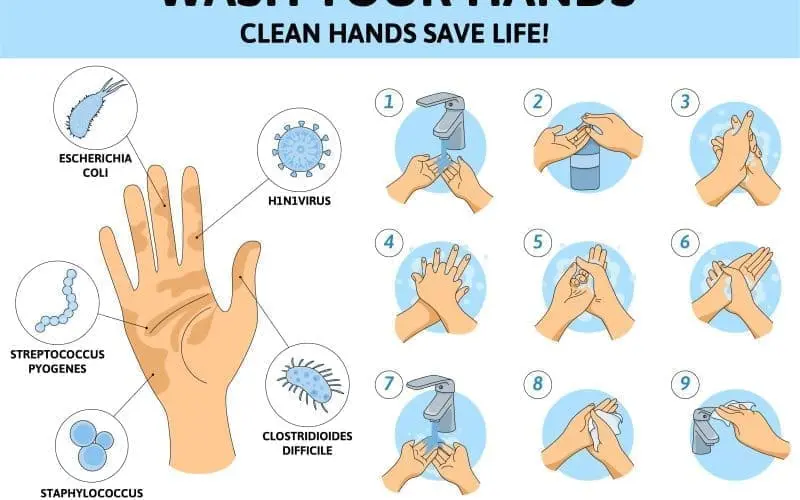A skincare routine, hair care routine, shower routine, sometimes we seem to have it all in place while neglecting the routine little things that actually affect our health. Washing hands may seem like a mundane task but it’s that little habit that can make a difference. A difference in moving towards better hygiene, and a much more significant health lifestyle choice. In this blog, you will gain insight into the 7 steps of washing hands, their importance, and the process of hand washing.
7 Steps of Washing Hands
The 7 steps of hand washing practice are a sword against the spread of germs and infections. Inculcated in your daily life, it can help in the prevention of diseases and their control at large. Let’s dive into the 7 steps of washing hands.
Step 1: Wet hands and apply soap
The process of hand washing begins with the first step, which is to wet your hands thoroughly. This is essential to wash away the visible dirt on the surface of your hands. Then use a good amount of soap and lather.
Step 2: Rub the palms together
The next step in the 7 steps of washing hands is to rub the palms vigorously to foam up your hands with lather. Use the foam to completely cover your palms and rub your hands together in a circular motion. This step in the 7 steps of hand washing is important to remove all the dirt that may not be visible to the naked eye.
Step 3: Rub the back of the hands
Most people stop with the two steps in the 7 steps of washing hands thinking they’ll get rid of all the germs and dirt. But we should realize that the back of the hands contain a lot of germs and bacteria and it is quite often neglected. So, in this step of the 7 steps of hand washing, use the lather to rub the back of your hands properly, rubbing against each other and covering the whole surface.
Step 4: Rub the back of the fingers
Now that you’ve rubbed the back of your palms together, the next in the 7 steps of washing hands is to rub your fingers together. To do this accurately, interlace your fingers and move them forward and backward. In between the fingers are places where dirt hides and settles.
Step 5: Rub and clean the thumbs
Palms, check. Fingers, check. Now thumbs are also centers where bacteria settle so it is important to ensure that you cover your thumbs and wash them thoroughly as well.
Step 6: Rub and clean the tips of the fingers
Now the absolute tips of your fingers and your fingernails also carry dirt so make sure you cover those areas too. Completely cover all the areas of your hands and also your wrist to ensure that through this step in the 7 steps of washing hands, your entire hands are covered with soap.
Step 7: Rinse the hands
Finally, in the last step of the 7 steps of washing hands, wash your hands under running water to remove any dirt residue and soap, and your hand washing routine is complete.
Why is hand washing so important?
- Our hands come in contact with a lot of different surfaces throughout the day, so it is important to ensure that we get all the germs off our hands. The 7 steps of hand washing are essential to remove all dirt, save ourselves from any infection, and prevent the spread of illness.
- Good personal hand hygiene is important to maintain good public health, and a sanitary environment to ensure collective well-being.
- Whether you are in a hospital setting tending patients, at home preparing food, or at the office, regular hand washing can prevent transmission of infection or contamination of food.
How do germs and infections spread?
Germs and infections can spread through different means. These are:
- Germs and bacteria can be spread through first of all direct contact. Coming in contact with an infected person by direct physical contact like hugs, handshakes, etc., or even by their bodily fluids.
- Secondly, germs spread through indirect contact, that is by coming in contact touching surfaces like doorknobs, switches, phone surfaces, etc that the infected person has touched.
- Respiratory illnesses like COVID-19 can be spread through coughing, sneezing, or spitting an infected person. These spread through the air and when another healthy person inhales this, they get infected too.
- Insects and other animals act as carriers of germs and spread them to humans. Food contaminated by insects can also cause the spread of germs and lead to serious illnesses. Dengue and malaria are examples of diseases spread by insects.
- Other ways of transmission include coming in contact with the blood of an infected person. This usually happens by sharing needles while taking drugs. Another way of transmission is through an infected pregnant woman to her child.
The 7 steps of washing hands are hence essential to prevent these kinds of direct or indirect transmission of germs and prevent illnesses. So be mindful of your small practices to ensure healthy living.


